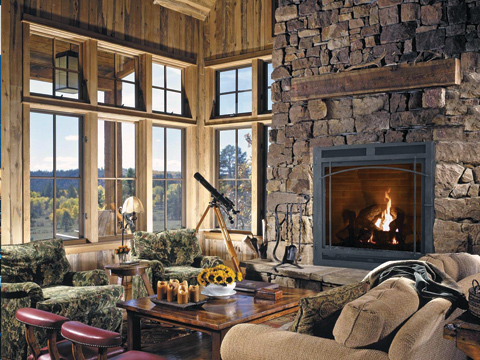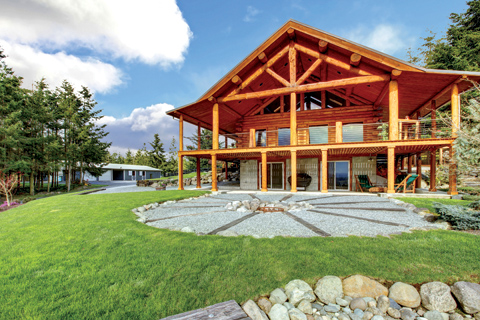Considering the rising costs of energy and the environmental awareness that is so necessary as natural resources become more scarce every day, log home owners are taking advantage of opportunities to maximize the energy efficiency of their homes on a regular basis. While doing so, they discover not only that savings in real dollars may be substantial, but also that their personal impact on the environment is becoming “greener.”
Those who are constructing their log homes and those who are purchasing an existing structure are likely to find that energy-efficient options exist throughout. Getting started is relatively simple. In addition to asking lots of questions and reading available information in print and on the Internet, take stock in the existing energy profile of the home or engage in a meaningful dialogue with the general contractor on the front end of a construction project.
“Several things are indicators of how energy efficient an existing log home is,” advises Rob Pickett, log structure consultant with Rob Pickett & Associates, LLC. “The first is to look at the fuel and power consumption that keeps the house comfortable for you. The second has to do with cold drafts in winter. It is not always appropriate to compare your home’s energy consumption to your neighbor’s unless they live in their house the same way you do, the homes are of similar design and solar orientation, and they were built to the same or similar energy codes.”
As for construction, Paul Peebles of Perma-Chink Systems, Inc., comments, “Start with a plan from the very beginning to build an energy efficient log home. Make your wishes known to the designer, manufacturer, the general contractor, and any and all subcontractors. Large benefits can be had from small details like orientation on the building site, roof overhangs, materials, and obviously insulation and appliances.”
Peebles also recommends investing in a blower-door test in conjunction with an infrared survey of a log home conducted by an EnergyStar or BPI-trained professional. This will identify any current problems with energy efficiency in the structure and allow the homeowner to take necessary steps to correct the situation. Energy efficiency challenges that arise with log homes are generally similar to those of any home: windows, foundations, doors, the top of the walls connecting to the roofline, around chimneys, and certainly with the appliances and mechanical aspects of the home.
“Log homes leak when they are not maintained properly, just like any other home,” adds Pickett. “Air infiltration is felt by the occupant as a draft. The difference in temperature between the outside air and the conditioned air entering the home has been said to consume as much as 30 to 40 percent of a home’s energy bill.”

Two immediate issues involving energy efficiency include the main element—the logs themselves—and the type and amount of insulation used in the construction of the home. Chris Wood, vice president of sales with Hearthstone, Inc., advises, “Don’t let the trivial wood characteristics tail wag the dog. Buy what you like to look at and make the system tight. Air leakage management is more important than any species decision. Cedar has a higher R-value than oak, but when either gets soaked up with energy, the radiant heat is comfortable to the touch. Logs should be well crafted and airtight, both initially and after the home is finished with shrinkage and settling after two or more years.
“Insulation should be closed cell, foil-faced rigid urethane foam in the roof, either R-38 or R-49 per code,” Wood continues, “and spray foam closed-cell thin layer insulation should be on the exterior surface of conventionally framed dormer walls and gable ends to keep the air out. Fiberglass or open cell insulation that allows for shrinkage and settling should fill the remaining cavities to meet code, and open-cell foam or fiberglass should be used above windows and doors.”
Proceed with caution when choosing windows either for new construction or to replace those in an existing log home. Deciding on the right windows or any other building products requires consideration of performance and durability, says Stacy Einck, brand public relations manager at Andersen Windows. Additionally, depending on the product, aging windows or those with broken seals can be upgraded to state-of-the-art performance.
“Be sure you choose windows that are dependable and perform with the energy efficiency you expect,” Stacy notes, “and consider durability features so your product performs well for a long time. That protects your investment and saves you money at the same time. Choose building products wisely and take special care with the building envelope itself. You can always upgrade interiors and appliances. You will save heating and cooling costs with energy efficient windows and doors while providing a durable structure for years to come.”
Personal preference does play a role in determining the most energy efficient water heating and air conditioning options. Wood advocates instant-on, tankless water heaters fueled by natural gas if that is also used with the main house, or 80-amp electric power if room is available in the electrical panel. He also suggests natural gas forced-air heating, particularly with temperatures dipping below 30 degrees, while the same ductwork and system may utilize electric air conditioning with efficiencies above 90 percent.
For anyone considering a log home construction project, energy efficiency looms large in the overall budget, comfort, value, and environmental equation. Balancing these elements takes care and attention to detail.
“I would say a good general contractor is a priority because they can have the single biggest impact on how your house performs,” relates Pickett. “Second would be to specify that the house be certified to EnergyStar and/or the National Green Building Program. These two programs are designed to create an efficient, sustainable, healthy living environment. Certifying to one or both of these assures you that air sealing and insulation levels are correctly installed.”
Energy-efficiency makes sense for log homeowners, providing confidence that value and comfort are achievable in concert with one another and making a tremendous contribution to the overall satisfaction of living the log home lifestyle.

